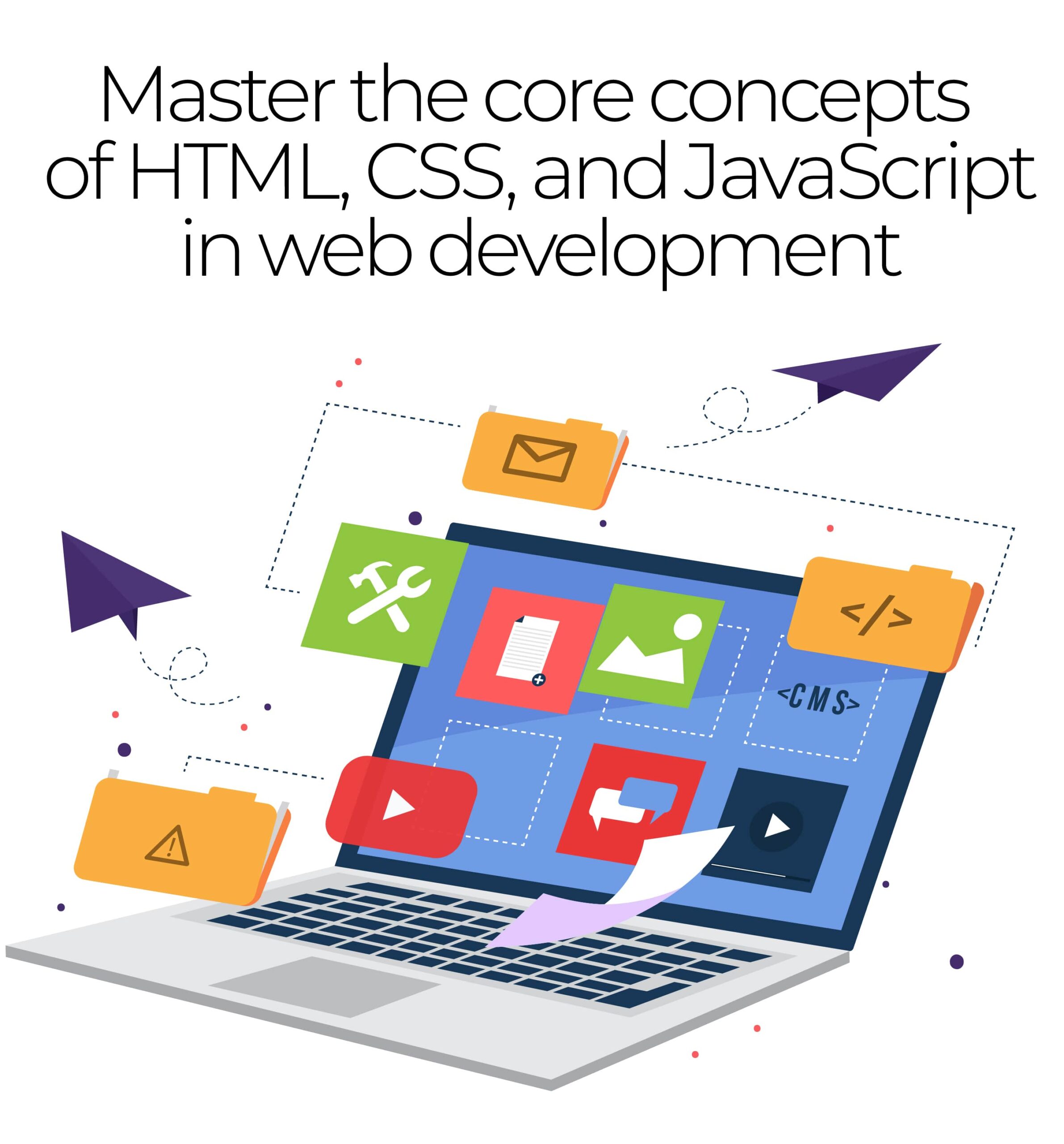
Understanding the Basic Blocks of Web Development – HTML, CSS, and JavaScript
Are you looking for a comprehensive guide to understand the how website development is done? Or do you want to learn about fundamental programming languages? In this blog, we’ll learn about HTML, CSS, and JavaScript, the building blocks of website development. In this how-to guide, we’ll look at the most important parts that give coders the tools they need to make dynamic, interactive web pages.


The Most Fundamental in Website Development – HTML
HTML, which stands for “HyperText Markup Language,” is the standard language used to make the structure and text of web pages. It forms the basis for building websites because it specifies the parts and designs that make up a page. Front-end developers utilize HTML as a markup language, which means that they use tags and elements to tell system how to show different parts of a web page.
HTML is used to organize and style the different parts of a website and acts like the page’s skeleton. Each HTML element in web development is shown by a tag, and the beginning and end of each element are shown by putting the tags in angle brackets (>). Between the opening and ending tags is where the element’s content goes.
HTML is utilized in website development in the following ways:
- Structure: HTML allows developers to create the fundamental structure of a webpage. Elements like headings (<h1>, <h2>, etc.), paragraphs (<p>), lists (<ul>, <ol>), and more, help organize and present information in a structured manner.
- Links and Navigation: HTML provides the ability to create hyperlinks using the anchor tag (<a>). This allows users to navigate between different web pages and resources, forming the backbone of website navigation.
- Images and Media: HTML includes tags to embed images (<img>) and multimedia content like videos and audio files, enhancing the visual appeal and interactivity of web pages.
- Forms: HTML forms (<form>) enable users to submit data to a server, facilitating various interactive elements like login forms, contact forms, and search boxes.
- Accessibility: HTML offers semantic elements that contribute to web accessibility, ensuring websites are more inclusive and easily understood by users with disabilities or assistive technologies.
- Responsive Design: With HTML, developers can implement responsive design techniques, using media queries and other elements to create web pages that adapt to different screen sizes and devices.
In short, HTML is the most important part of building websites because it gives web pages their basic structure and text.
Who Are We?
We cater to all your business needs from digital
marketing to website development!

The Dynamics of CSS
CSS or Cascading Style Sheets, is a style sheet language used to control how website development is done via HTML. It tells you how a webpage should be organized and what it should contain, while CSS tells you how that content should be presented and styled.
CSS works on the concept of cascading, which means that multiple CSS rules can be applied to the same HTML element, and the browser decides the final style based on the priority and specificity of these rules

- Styling: CSS allows developers to apply styles to HTML elements, such as defining font types, colors, sizes, and text formatting. It enables consistent and visually appealing typography throughout the website.
- Layout: CSS is instrumental in controlling the layout and positioning of elements on a webpage. It provides options for creating responsive and adaptive designs, adjusting the positioning of elements based on screen size and orientation.
- Selectors: CSS uses selectors to target specific HTML elements and apply styles to them. Class selectors, ID selectors, and element selectors are commonly used to identify and style specific sections of a webpage.
- Box Model: CSS implements the box model, which defines how the content, padding, borders, and margins of an element are structured and interact with each other. This helps in accurately spacing and sizing elements on a webpage.
- Flexibility: With CSS, developers can create complex and sophisticated layouts, such as multi-column designs, grid systems, and sophisticated animation effects, enhancing the user experience and visual appeal.
- Responsive Design: CSS is a crucial tool for building responsive websites that adapt to different devices and screen sizes. Media queries in CSS allow developers to customize the presentation of content based on the user’s device, optimizing the user experience on various platforms.
- Theming: CSS makes it easy to apply different styles and themes to a website without altering its underlying HTML structure. This flexibility allows for quick and efficient customization of the website’s appearance.
For a back-end developer, CSS is a critical component of website development. It manages the visual presentation and layout of online pages. It works in tandem with HTML, hence improving overall user experience and branding.
Grow Human-Centered
Businesses
Online
Web App Vault is a custom web design and business
website development company that enhances the visibility
and credibility of businesses. We are an approachable
eCommerce service provider that fuels digital marketing.
We Are Here To Help
Learning JavaScript
JavaScript is a powerful and dynamic programming language that is used in website development to add interaction, functionality, and dynamic content. It enables developers to construct responsive and dynamic web experiences, enhancing the engagement and usability of websites.
JavaScript is a client-side scripting language, meaning it runs in the user’s web browser rather than on the web server. This allows for real-time interactions with the webpage while avoiding the need for ongoing contact with the server.
- Interactivity: JavaScript enables developers to create interactive elements on web pages, such as buttons, sliders, dropdown menus, and more. These elements respond to user actions like clicks, keypresses, or mouse movements, providing a rich and engaging user experience.
- Form Validation: JavaScript can be used to validate form input data on the client-side before it is submitted to the server. This helps ensure that users provide the correct and expected information, reducing errors and improving data integrity.
- Dynamic Content: JavaScript allows developers to manipulate the Document Object Model (DOM) of a web page, enabling them to add, remove, or modify HTML elements and content dynamically. This capability is especially useful when updating page content without the need to reload the entire page.
- APIs and AJAX: JavaScript can interact with APIs (Application Programming Interfaces) to retrieve and display data from external sources, such as databases or third-party services. AJAX (Asynchronous JavaScript and XML) enables seamless data exchange between the client and server, allowing for smoother and more responsive user interactions.
- Event Handling: JavaScript facilitates event-driven programming, where developers define how the webpage responds to specific events triggered by user interactions. Events like clicks, mouse movements, or keyboard inputs can be easily managed and handled with JavaScript.
- Animations and Effects: JavaScript allows for the creation of animations and visual effects on web pages, enhancing the overall user experience and making websites more visually appealing.
- Frameworks and Libraries: JavaScript has a vast ecosystem of frameworks and libraries, such as jQuery, React, Vue.js, and Angular, which provide pre-built components and functionalities to simplify and accelerate website development.
JavaScript is critical in website creation because it allows developers to construct interactive, dynamic, and user-friendly web pages.
Web App Vault – Your
Industry-Specific
Data Guardian
Our industry-specific web application solution
provides robust data security and a seamless user
experience tailored to your industry’s requirements.
Safeguard your sensitive data with assurance.

Providing Animation Services To
Clients In Multiple Cities Across USA & Canada
- Arlington
- Cleveland
- Jacksonville
- Miami
- Orlando
- Atlanta
- Dallas
- Louisville
- Minneapolis
- Philadelphia
- Austin
- Denver
- Kansas City
- New York
- Portland
- Chicago
- Houston
- Los Angeles
- New Orleans
- San Diego
Harmonizing all Three
HTML, CSS, and JavaScript all contribute in the process of website development to produce dynamic and interactive web pages. HTML serves as the page’s structural backbone, establishing its content and layout. CSS handles styling, establishing how material should be presented and ensuring a uniform visual appearance throughout the site. JavaScript, on the other hand, provides interactivity and functionality to websites, allowing developers to construct responsive elements, handle user interactions, and dynamically modify page content.
When a user sees a web page, the browser initially loads the HTML, which contains the page’s fundamental structure, such as headings, paragraphs, graphics, and other elements. CSS then takes over to apply the developer-specified styles, such as fonts, colors, margins, and placement. As a result, the page has a more polished and visually appealing appearance.

JavaScript, on the other hand, is what truly brings a website to life. This scripting language interacts with HTML and CSS, allowing developers to dynamically change the DOM. JavaScript may respond to user events like as clicks and keystrokes by changing the page’s content or appearance without requiring a page reload. This provides the user with a seamless and interactive experience.
Don’t forget that practice makes perfect. As you keep getting better at web development, keep trying out new methods and pushing the limits of what you can do. The online world is always changing, so if you want to stay ahead in this exciting field, you need to be able to change and be willing to learn.
So, leap into the boundless possibilities and get a website development consultant at Web App Vault to be your trusted companion. We guide you how to unlock the full potential of your online presence, website development that resonates with your audience, amplifies your message, and establishes your rightful place in the ever-evolving digital landscape.
